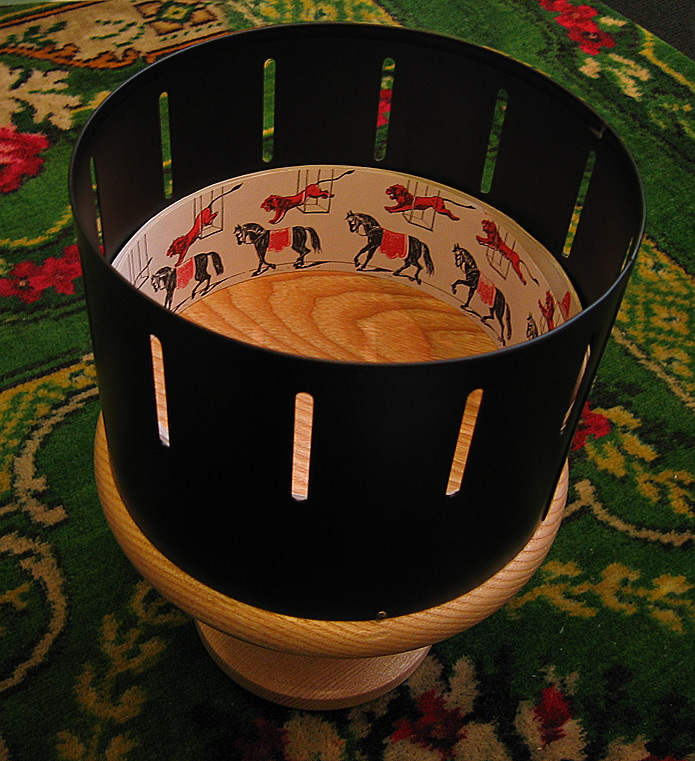|
Andotrope
An Andotrope is a device that allows viewing of a two-dimensional video from any direction, without limiting it to a specific perspective as with conventional screens. Name and idea The device is named after its inventor, Mike Ando, with the suffix ''-trope'' (Ancient Greek τρόπος, "turning"). The idea came to Ando working on his at the end of 2022 started eight month project for re-creating the ''Gehn’s Holographic Imager'' of the computer game Riven – The Sequel to Myst for the Mysterium 2023. The Andotrope is a replica of this device, but differs from a technical perspective in that the image is not a three-dimensional hologram. Functionality According to Ando, the device updates "a 150-year-old children’s toy into the 21st century.” The functionality of an Andotrope is similar to a Zoetrope, but differs technically on several key points. The device is built from a cylindrical housing containing at least one fixed screen. The cylinder has a slot for each scre ... [...More Info...] [...Related Items...] OR: [Wikipedia] [Google] [Baidu] |
Zoetrope
A zoetrope is a Precursors of film#Modern era, pre-film animation device that produces the illusion of motion, by displaying a sequence of drawings or photographs showing progressive phases of that motion. A zoetrope is a cylindrical variant of the phenakistiscope, phénakisticope, an apparatus suggested after the stroboscopic effect, stroboscopic discs were introduced in 1833. The definitive version of the zoetrope, with replaceable film picture film strips, was introduced as a toy by Milton Bradley Company, Milton Bradley in 1866 and became very successful. Etymology The name ''zoetrope'' was composed from the Greek root words ζωή ''zoe'', "life" and τρόπος ''tropos'', "turning" as a translation of "wheel of life". The term was coined by inventor William E. Lincoln, of Providence, Rhode Island. Technology The zoetrope consists of a cylinder with cuts vertically in the sides. On the inner surface of the cylinder is a band with images from a set of sequenced pictures. ... [...More Info...] [...Related Items...] OR: [Wikipedia] [Google] [Baidu] |
Ancient Greek
Ancient Greek (, ; ) includes the forms of the Greek language used in ancient Greece and the classical antiquity, ancient world from around 1500 BC to 300 BC. It is often roughly divided into the following periods: Mycenaean Greek (), Greek Dark Ages, Dark Ages (), the Archaic Greece, Archaic or Homeric Greek, Homeric period (), and the Classical Greece, Classical period (). Ancient Greek was the language of Homer and of fifth-century Athens, fifth-century Athenian historians, playwrights, and Ancient Greek philosophy, philosophers. It has contributed many words to English vocabulary and has been a standard subject of study in educational institutions of the Western world since the Renaissance. This article primarily contains information about the Homeric Greek, Epic and Classical periods of the language, which are the best-attested periods and considered most typical of Ancient Greek. From the Hellenistic period (), Ancient Greek was followed by Koine Greek, which is regar ... [...More Info...] [...Related Items...] OR: [Wikipedia] [Google] [Baidu] |
Frame Rate
Frame rate, most commonly expressed in frame/s, or FPS, is typically the frequency (rate) at which consecutive images (Film frame, frames) are captured or displayed. This definition applies to film and video cameras, computer animation, and motion capture systems. In these contexts, frame rate may be used interchangeably with and refresh rate, which are expressed in hertz. Additionally, in the context of computer graphics performance, FPS is the rate at which a system, particularly a GPU, is able to generate frames, and refresh rate is the frequency at which a display shows completed frames. In electronic camera specifications frame rate refers to the maximum possible rate frames could be captured, but in practice, other settings (such as exposure time) may reduce the actual frequency to a lower number than the frame rate. Human vision The temporal sensitivity and resolution of human vision varies depending on the type and characteristics of visual stimulus, and it differs betw ... [...More Info...] [...Related Items...] OR: [Wikipedia] [Google] [Baidu] |
Animation Technology
Animation is a filmmaking technique whereby image, still images are manipulated to create Motion picture, moving images. In traditional animation, images are drawn or painted by hand on cel, transparent celluloid sheets to be photographed and exhibited on film. Animation has been recognised as an artistic medium, specifically within the Entertainment#Industry, entertainment industry. Many animations are either traditional animations or computer animations made with computer-generated imagery (CGI). Stop motion animation, in particular claymation, has continued to exist alongside these other forms. Animation is contrasted with live action, although the two do not exist in isolation. Many moviemakers have produced Live-action animation, films that are a hybrid of the two. As CGI increasingly Photorealism, approximates photographic imagery, filmmakers can easily Compositing, composite 3D animations into their film rather than using practical effects for showy visual effects (VFX). ... [...More Info...] [...Related Items...] OR: [Wikipedia] [Google] [Baidu] |

